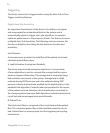
Trilogy200 clinical manual
32
Rise Time
In S, S/T, PC, T, PC-SIMV, and SIMV modes, rise time is the amount
of time it takes the device to change from the expiratory pressure
setting to the inspiratory pressure setting. Rise time levels of 1, 2,
3, 4, 5, or 6 progressively reect slowed response of the pressure
increase that will take place at the beginning of inspiration. Adjust
the rise time to nd the most comfortable setting for the patient.
PRESSURE
IPAP
EPAP
TIME
Rise Time
AVAPS Feature
Average Volume Assured Pressure Support (AVAPS) is a feature
available in the S, S/T, PC, and T modes. It helps patients maintain
a tidal volume (V
T
) equal to or greater than the target tidal volume
(Volume setting in the ventilator) by automatically controlling the
pressure support (PS) provided to the patient. The AVAPS feature
adjusts PS by varying the IPAP level between the minimum (IPAP Min)
and maximum (IPAP Max) settings. AVAPS averages V
T
and changes
the PS value gradually. This occurs over several minutes. The rate of
change is slow, so that the patient is not aware of breath-to-breath
pressure changes.
As patient eort decreases, AVAPS automatically increases PS to
maintain the target tidal volume. The IPAP level will not rise above
IPAP Max, even if the target tidal volume is not reached. Conversely,
as patient eort increases, AVAPS will reduce PS. IPAP will not fall
below IPAP Min, even if the target tidal volume is exceeded.
If the Ramp function has been activated, it will take precedence over
the AVAPS feature. Once ramp is complete, AVAPS will resume.
Rise Time
Note: AVAPS is only available if
you are using a passive circuit.
Note: C-Flex, Bi-Flex and AVAPS
are intended for use by adult
patients.


















